ISSN
2307–3489 (Print), ІSSN
2307–6666
(Online)
Наука
та прогрес транспорту. Вісник
Дніпропетровського
національного університету залізничного
транспорту, 2020, № 1 (85)
ТРАНСПОРТНЕ
БУДІВНИЦТВО
Транспортне
будівництво
UDC
624.94.014.2:519.6
D.
V. ROZUMENKO1,
D. О. BANNIKOV2*
1Fac.
«Industrial and Civil Engineering»,
Dnipro National University of Railway Transport named after
Academician
V. Lazaryan, Lazaryana St., 2,
Dnipro, Ukraine,
49010, tel. +38 (099) 681 68 38, e-mail
dmitriy.rozumenko.v@gmail.com, ORCID
2*Dep.
«Construction Production
and Geodesy»,
Dnipro National University of Railway Transport named after
Academician
V. Lazaryan, Lazaryana St., 2,
Dnipro, Ukraine,
49010, tel. +38 (063) 400 43 07, e-mail bdo2020@yahoo.com,
ORCID 0000-0002-9019-9679
DYNAMIC
PROPERTIES OF ONE-STOREY
INDUSTRIAL BUILDING
Purpose.
Recently, there has been a growing demand in Ukraine for the reuse of
industrial buildings that have not been in exploitation for a certain
period of time. At the same time, there are frequent cases when new
technological equipment transfers significant dynamic loads to
existing structures over a long period of time. Since the available
data regarding the dynamic properties of industrial buildings are now
practically absent, the main goal of the studies made by the authors
is to evaluate and analyze own dynamic characteristics of a
one-storey industrial building. Methodology. To achieve this
goal, it was necessary first to choose the type of industrial
building, which is common enough for the formulated conditions of the
reuse possibility. A one-storey unheated industrial building with
three purlins (purlins 15 + 15 + 6 m) with a steel supporting frame
was taken as such a building. In the course of research, the cross
sections of the main load-bearing elements were varied, as well as
the schemes of their connection with each other. The calculations
were carried out by the finite element method based on the Lira for
Windows project complex. Findings. The obtained frequency
spectra of the own dynamic characteristics for the main bearing
structural elements of an industrial building of the type in question
are in the range up to 30 Hz. Also, during the research, dependencies
were obtained for changing this range for various cases of design
decisions of the building. Originality. The research results
presented in the publication make it possible to evaluate the range
of the own dynamic characteristics of single-storey multipurlined
unheated industrial buildings with the traditional structural
solution of the steel frame. Practical value. The resulting
range of the own dynamic characteristics of the industrial building
of the type in question is quite dangerous for human health. The most
unfavorable is the oscillation form of the columns, which actually
involves the entire structural frame. Therefore, in the course of
research, a special method was developed and tested to stabilize such
vibrations «on the base» using flexible ropes.
Keywords:
industrial building; modal analysis; dynamic characteristics;
finite element method; complex Lira for Windows
Introduction
Today, a significant number of
industrial buildings of various types and purposes were accumulated
in Ukraine, which have not been in operation for a long time. Their
construction falls on the second half of the twentieth century, and
the corresponding space-planning and design solutions also meet the
requirements of this period.
The desire of modern private
companies to save some money while developing their own businesses
leads to the reuse of such buildings. At the same time, the
available space-planning and design solutions they remain unchanged,
trying to use them with modern production technologies. This
approach is quite often implemented without any specialized project,
without further professional calculations and even without basic
feasibility studies.
As a result, the new
technological equipment is placed directly on the existing elements
of the supporting structures, it is attached virtually without
special design decisions. Quite often the duration of continuous
operation of the equipment is measured by hours, and in some cases
its operation is round the clock. At the same time, one of the
factors in the operation of such equipment is often the dynamic
impact caused by its moving parts.
The main component of such a
dynamic impact is the vibration, which manifests itself in the form
of transmission of the dynamic loading with a certain
amplitude-frequency spectrum to the structural elements. As a
consequence, the static work of load-bearing structures of the
building, provided by the design and engineering documentation, is
disrupted, transforming into a dynamic work.
The consequences of such a
situation are manifested in a short period of time in the form of
various damage and failure of the supporting structure elements,
disruption of their proper functioning.
Purpose
Taking into account the
above-mentioned, the main purpose of our study is to evaluate the
dynamic characteristics of a one-storey industrial building.
To achieve this goal, it was
necessary to first select the type of industrial building, which is
quite common for the formulated conditions of the reuse possibility,
and then to conduct a modal analysis of its design solution.
Methodology
A
single-storey, unheated industrial building with three purlins of 15
+ 15 + 6 m was selected for the study. Its
design solution is framed with the use of classical arrangement,
which is described in detail in many professional sources, for
example, [6]. The load-bearing elements are transverse frames,
spaced in 5.3 m increments. The edge columns are made with a solid
cross-section; valley stanchions have a two-stage construction with
an in-through bottom. Trusses with a diagonal lattice, additional
vertical posts and top cord slopes of 8.8º (15.6%) and 14.4º
(25.8%), which, incidentally, is contrary to modern requirements
[14], are provided as a ledger. The general view and design of the
building under consideration are shown in Fig. 1. The material of
the load-bearing elements of the frame was chosen steel, which is
related to its lower logarithmic decrement of damping oscillations
in comparison with reinforced concrete or wood [9, 10].
It should be noted that this
type of industrial buildings with small purlins is also widespread
and popular in our time abroad [13].
The study was conducted in
several stages, each of which evaluated own dynamic characteristics
of the building under consideration.
At the first
stage, the influence of the building
length was assessed. Herewith, three cases were considered: building
with the 4-step length of load-bearing transverse frames (the main
variant), 6 and 10 steps, which made the total length of the
building of 21.2; 31.8 and 53 m respectively.
At the second
stage, the influence of the connection
of the load-bearing transverse frame of the building with the
foundation was assessed. Two cases of rigid and hinge connection are
considered.
At the third
stage, the influence of the rigidity
of the main structural elements of the building – truss, column,
crane beam, as well as roof purlins and longitudinal struts – was
assessed.
To perform all these variant
calculations, we used extremely popular in recent decades and tested
numerical method of construction mechanics. It is the finite element
method [12, 15, 17] based on the widely known domestic software
complex Lira for Windows [11].
The constructed design model for
the basic structural variant of the production building is shown in
Fig. 2. All structural elements are simulated using rod finite
elements of universal type from the standard library of the complex.
The calculations were performed in geometrically and physically
linear form. This approach avoided the issues of estimating the
results convergence characteristic of finite elements of other types
[4, 5].
It should be noted separately
that performing dynamic calculations of building constructions is
not regulated by any normative documents in our time. The current
standard for designing steel structures in Ukraine [3] contains only
guidance on the feasibility of their performance, but does not
specify either the methods or the extent of their performance. The
Ukrainian standard for determining the structural loading [2]
contains no guidance at all on the calculation of dynamic loadings.
The standard for determining seismic loadings [1] partially fill
this gap, but such calculations are of a specific nature and are
not suitable for performing, for example, modal analysis of spatial
building structures, which also include single-storey industrial
buildings under consideration. Therefore, it is often necessary to
borrow certain techniques and methods from other industries, first
of all – mechanical engineering [16]. In particular, supreme
frequency screening algorithms were applied, and only the first
natural frequencies were taken into account.
Findings
The results
of modal analysis for all three stages of research are summarized in
Table 1. The lower natural partial frequencies for the basic
structural elements are presented. In Fig. 3 –
6 the oscillation forms of the basic
structural elements for the case shown in Table 1 in dark color are
presented. For all other cases, the fluctuation forms
were qualitatively identical.
а
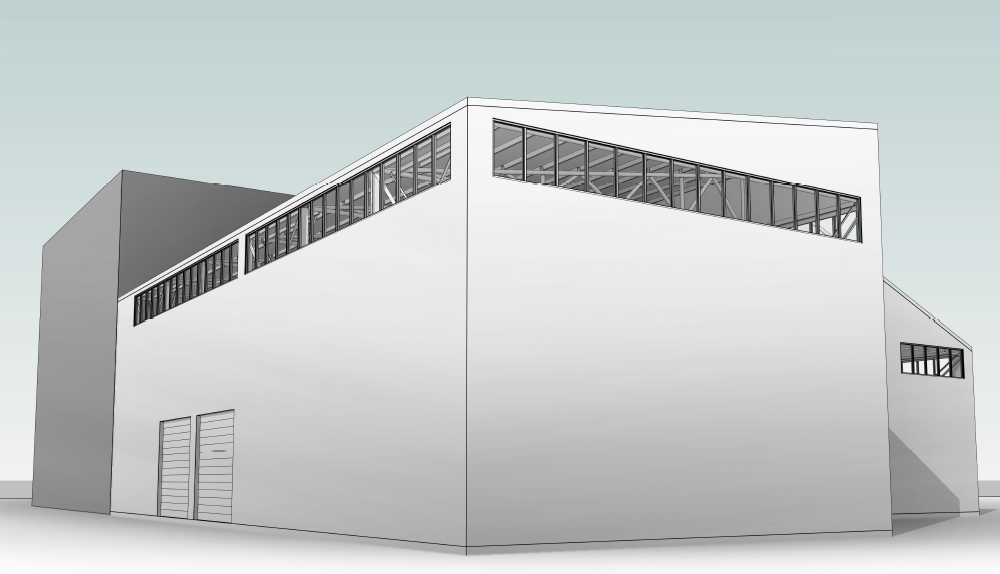
b
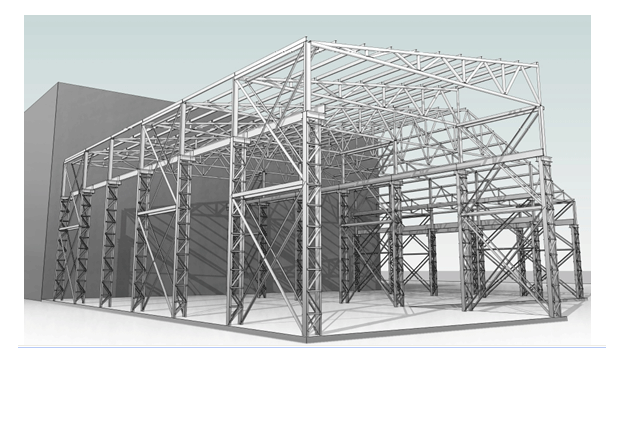
Fig.
1. The
object
research
–
one-storey
industrial
building:
а
– general
view;
b
– design
solution
Table
1
Natural
frequency spectrum of a one-storey
production building (Hz)
|
Connection
|
Rigid
|
Hinge
|
|
Frame
spacing
|
4
|
6
|
10
|
4
|
|
Section
of truss members
|
square
|
square
|
circle
|
angles
|
|
square
|
square
|
square
|
|
|
initial
|
Changed
with reduced rigidity
|
|
Element
of building
|
|
|
Truss
|
0.509
|
0.344
|
0.306
|
0.297
|
0.307
|
0.296
|
0.343
|
|
Column
|
2.787
|
1.978
|
1.867
|
1.881
|
1.961
|
1.847
|
1.977
|
|
Roof
purlins
|
5.203
|
4.269
|
4.288
|
4.288
|
4.288
|
4.288
|
4.269
|
|
Crane
beam
|
7.164
|
5.695
|
5.599
|
5.608
|
5.595
|
5.591
|
5.692
|
|
Struts
|
25.401
|
22.384
|
22.448
|
22.577
|
22.465
|
22.128
|
22.410
|
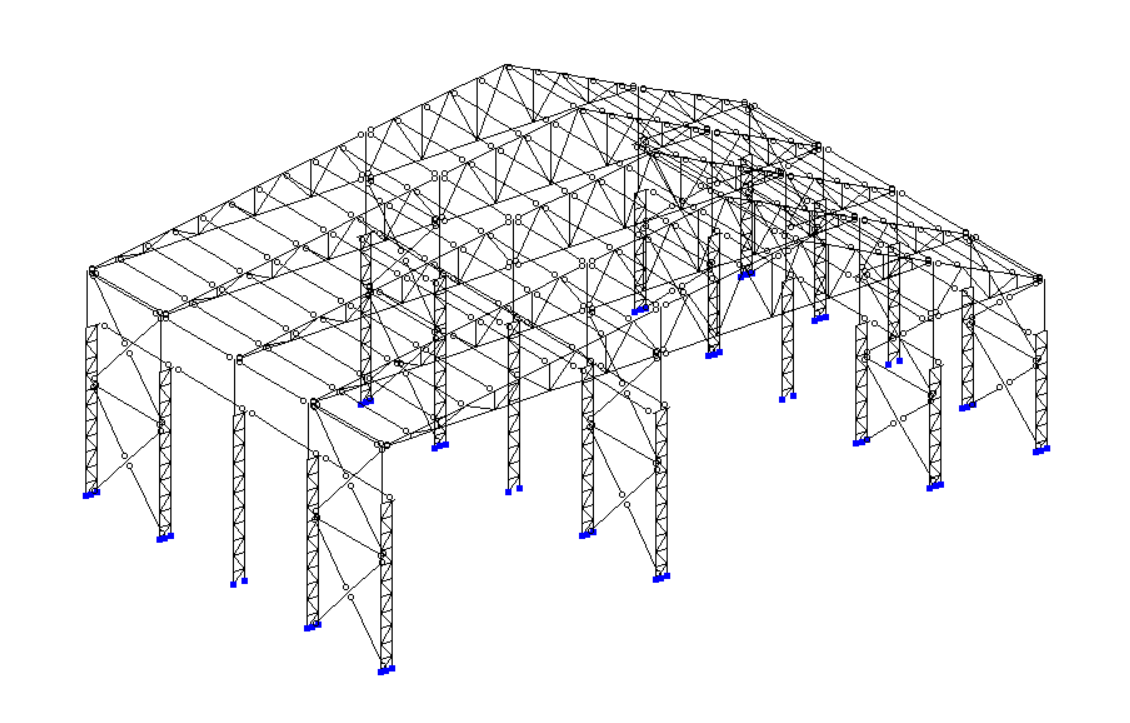
Fig.
2. Finite element model of industrial building
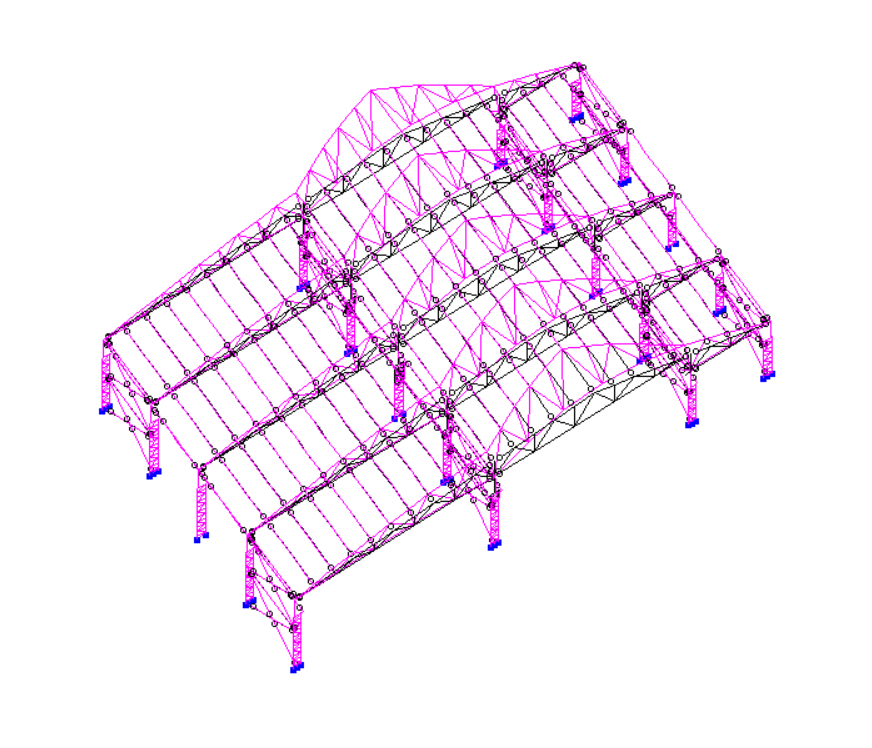
Fig.
3. The obtained lowest oscillation form of trusses of
industrial building
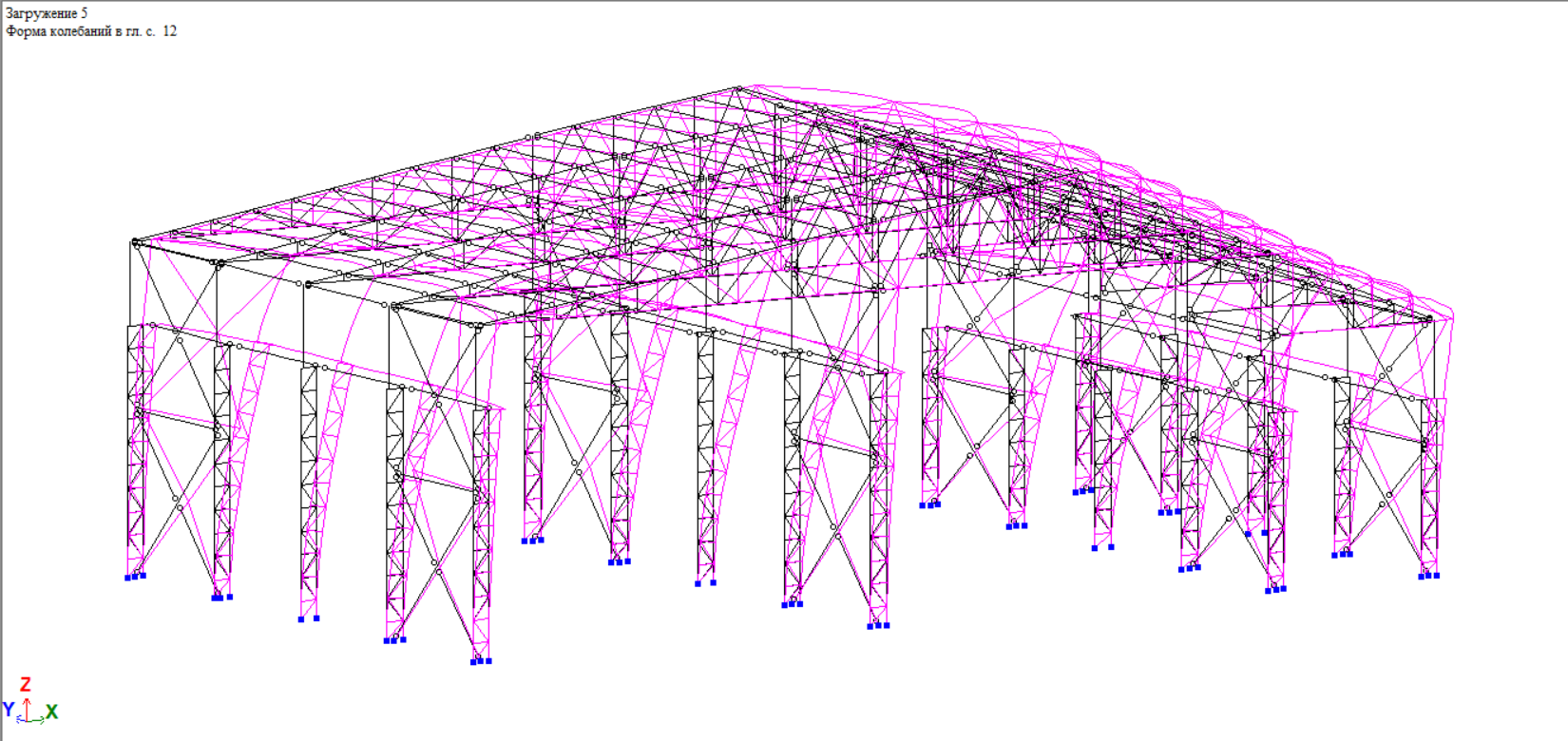
Fig.
4. The obtained lowest oscillation form of columns of
industrial building
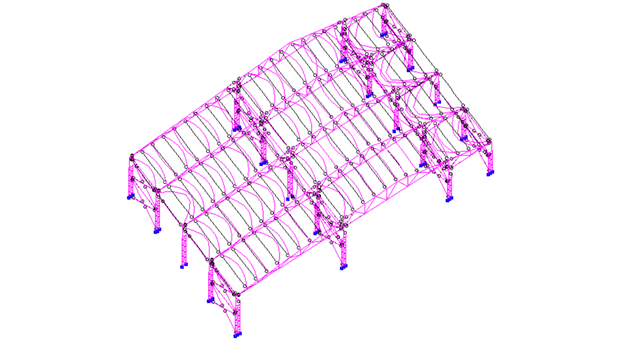
Fig.
5. The obtained lowest oscillation form of roof purlins of
industrial building
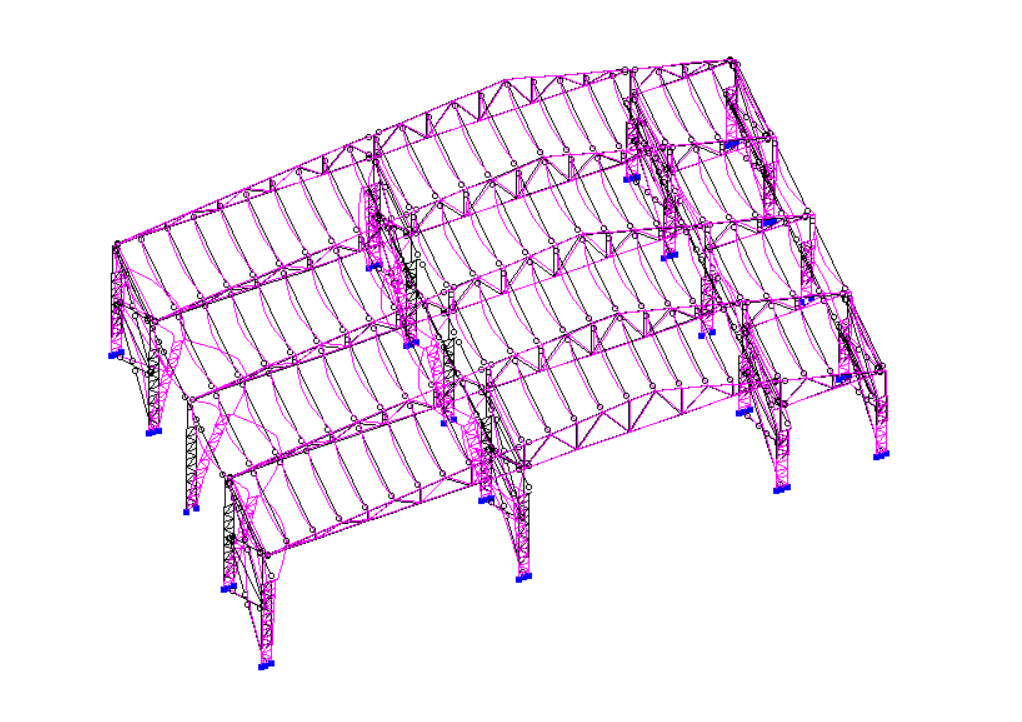
Fig.
6. The obtained lowest oscillation form of crane beams of
industrial building
As can be seen from the obtained
data, the frequency spectrum is in rather dangerous range for the
human, which is presented in Table 2 according to the data of the
work [8]. However, the impact on it of all the factors considered –
the building length, the nature of connection to the foundation and
the rigidity of the structural elements – is quite insignificant.
The most
dangerous was the oscillation form of the columns of industrial
building, which in fact involves the whole structural framework. The
frequency of such oscillations is also the most dangerous.
Therefore, at the fourth stage
of the research the stabilization of this form was considered in
more detail.
Table
2
Natural
human frequency spectrum (Hz)
|
No.
|
Human
organ
|
Resonant
frequency
|
|
1
|
Vestibular
apparatus
|
0.5–13
|
|
2
|
Stomach
|
2–3
|
|
3
|
Intestines
|
2–4
|
|
4
|
Body
|
2–5
|
|
5
|
Heart
|
4–6
|
|
6
|
Kidneys
|
6–8
|
|
7
|
Head
|
20–30
|
|
8
|
Eyebulbs
|
60–90
|
Of all the modern methods of
stabilization in accordance with the work [7], the most effective
for the conditions of the studied industrial building is the
structural one. The authors have developed and tested a way to
stabilize the «base» using the flexible ropes – Fig. 7.
In this case, the natural
partial oscillation frequency increased to 5.136 Hz, which reduced
its potential effect on human. The new form of oscillation for this
case is shown in Fig. 8.
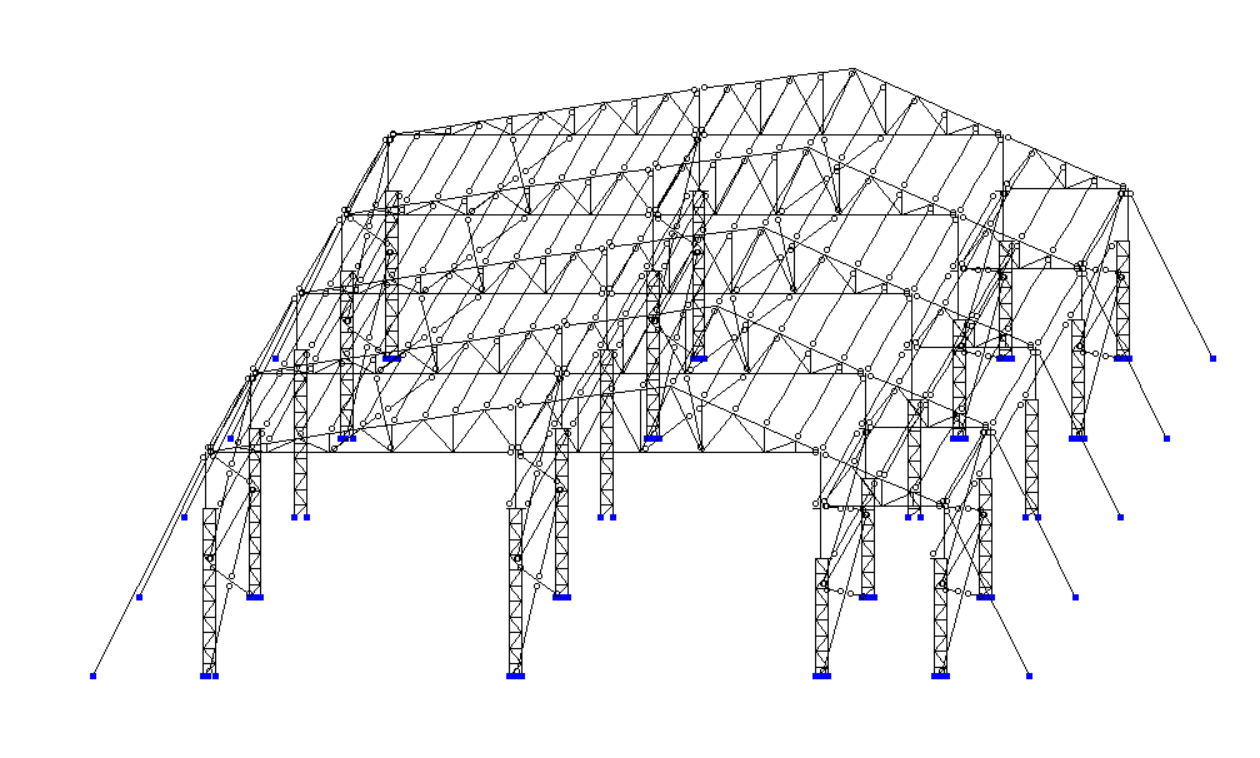
Fig.
7. Finite element model of industrial building
with additional
ropes to stabilize «on the base»
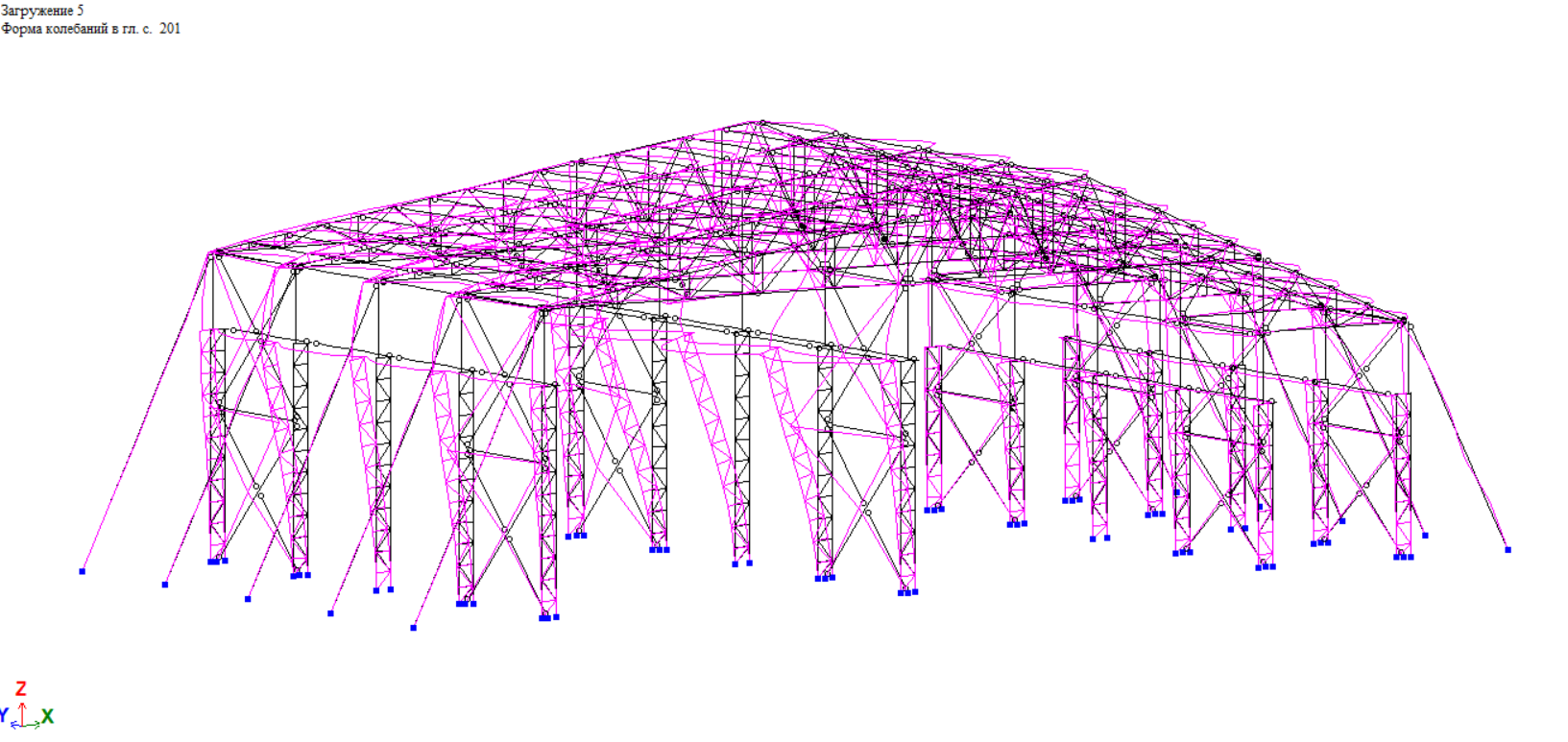
Fig.
8. The obtained oscillation form of the
industrial building
with additional
ropes to stabilize the «base»
Originality and practical
value
The results
of the studies presented in the publication allow us to estimate the
spectrum of natural dynamic characteristics of single-storey
multipurlined unheated industrial buildings with the traditional
structural design of the steel frame. As the obtained range of
natural dynamic characteristics of the industrial building of the
investigated type is rather unsafe for human health, the authors
have developed a way of shifting the frequency spectrum to a safer
zone. It consists in applying the stabilization of the most
unfavorable form of columns` oscillation in industrial building «on
the base» by means of flexible ropes. The effectiveness of this
decision was confirmed during the studies performed.
It should also be noted that
this structural proposal is quite simple in terms of practical
implementation and can be applied not only to industrial buildings
with steel bearing frame, but also to other types of existing frame
buildings, in particular for civilian or agricultural purposes.
Conclusions
Based on the material stated in
the publication, we can draw the following conclusions:
1. The spectrum of natural
dynamic characteristics of a single-storey non-heated industrial
building with a bearing steel frame is quite dense and for the lower
frequencies (up to 30 Hz) it is presented for all the basic
structural elements. This is potentially hazardous to human health
because the spectrum obtained is quite consistent with that of human
resonance characteristics.
2. The influence on the own
dynamic characteristics of industrial building of the type under
consideration, such as the building length, the connection nature
with the foundation, and the rigidity of the structural elements,
are quite insignificant.
3. In
order to stabilize the most unfavorable oscillation form of the
frame of the industrial building under consideration, a method of
stabilizing «on the base» using the flexible ropes was proposed
and tested by numerical calculations. It also makes it possible to
shift the appropriate frequency spectrum to a safer zone.
LIST OF REFERENCE LINKS
Банніков
Д. О. Оцінка практичної
збіжності результатів аналізу
пластинчастих моделей в методі скінчених
елементів. Нові
технології в будівництві.
2017. № 32. С. 26–31.
Банников
Д. О., Гуслистая А. Э.
Оценка сходимости напряжений в
сложных металлоконструкциях методом
конечных элементов.
Металлургическая и горнорудная
промышленность. 2011. № 4. С. 93–96.
Буга П. Г.
Гражданские, промышленные и
сельскохозяйственные здания :
монография. Москва : Книга по требованию,
2013. 349 с.
ДБН
В.1.1-12:2006. Захист від небезпечних
геологічних процесів, шкідливих
експлуатаційних впливів, від пожежі.
Будівництво у сейсмічних районах
України. [Чинний від
2007-01-02]. Вид. офіц. Київ : Мін. буд-ва,
арх-ри та ЖКГ України, 2006. 84 с.
ДБН
В.1.2-2-2006 (зі змінами). Система надійності
та безпеки в будівництві. Навантаження
і впливи. Норми проектування.
[Чинний від 2007-01-01]. Вид.
офіц. Київ : Держбуд,
2007. 70 с.
ДБН
В.2.6-198:2014. Сталеві конструкції. Норми
проектування. [Чинний
від 2015-01-01]. Вид. офіц. Київ:
Мінрегіон, 2014. 205 с.
Казакевич
М. И., Кулябко В. В. Введение
в виброэкологию зданий и сооружений
: монография. Днепропетровск :
ПГАСА, 1996. 200 с.
Казакевич
М. И. Проблемы стабилизации
вант. Металлические
конструкции. 2011. Т.
17. № 2. С. 63–84.
Редченко
В. П. Динамічні
випробування мостів. Частина 1 : Загальні
положення, спектральний аналіз,
динамічні характеристики
: монографія. Дніпро : Пороги, 2016. 216 с.
Редченко
В. П. Динамічні
випробування мостів. Частина 2
: Вільні коливання,
модальний контроль :
монографія. Дніпро : Пороги, 2017. 216 с.
Стрелец–Стрелецкий
Е. Б., Журавлев А. В.,
Водопьянов Р. Ю. ЛИРА–САПР. Книга I :
Основы : монография / под ред. А.
С. Городецкого. Киев : LIRALAND, 2019.
154 с.
Bofang
Z. The Finite Element Method.
Fundamentals and Applications in
Civil, Hydraulic, Mechanical and Aeronautical Engineering.
Singapore : John Wiley & Sons
Singapore Pte. Ltd. 2018. 843 p.
10.1002/9781119107323
Johnson
R. P. Composite Structures of Steel
and Concrete: Beams, Slabs, Columns and Frames for Buildings
: monograph. Wiley Blackwell, 2018. 265 p. DOI:
10.1002/9781119401353
Kruhlikova
N. G.,
Bannikov D.
O. Rational
design of
shot-span
industrial
building roof
for
reconstruction
conditions. Наука
та прогрес транспорту.
2019. № 2 (80). P.
144–152. DOI: 10.15802/stp2019/165853
Neduzha
L. O., Shvets A. O. Theoretical
and experimental research of strength properties of spine beam of
freight cars. Наука та прогрес транспорту.
2018. № 1 (73). P.
131–147. DOI: 10.15802/stp2018/123457
Shames
I. H. Energy and Finite Element
Methods In Structural Mechanics :
monograph. New York : Routledge, 2017. 776 p. DOI:
10.1201/9780203757567
Singiresu
S. R. The Finite Element Method in
Engineering : monograph. Elsevier
Inc, 2018. 763 p.
DOI:
10.1016/c2016-0-01493-6
Д.
В. РОЗУМЕНКО1,
Д. О. БАННІКОВ2*
1Фак.
«Промислове та цивільне будівництво»,
Дніпровський національний університет
залізничного транспорту імені академіка
В. Лазаряна, вул. Лазаряна, 2, Дніпро,
Україна, 49010, тел. +38 (099) 681 68 38,
ел. пошта
dmitriy.rozumenko.v@gmail.com,
ORCID 0000-0001-6058-9417
2*Каф.
«Будівельне виробництво та геодезія»,
Дніпровський національний університет
залізничного транспорту імені академіка
В. Лазаряна, вул. Лазаряна, 2, Дніпро,
Україна, 49010, тел. +38 (063) 400 43 07, ел. пошта
bdo2020@yahoo.com,
ORCID
0000-0002-9019-9679
ДИНАМІЧНІ
ВЛАСТИВОСТІ ОДНОПОВЕРХОВОЇ
ВИРОБНИЧОЇ
БУДІВЛІ
Мета.
Зараз в Україні зростає
попит на повторне використання
промислових будівель, які протягом
певного часу не були в експлуатації.
При цьому частими є випадки, коли нове
технологічне обладнання передає на
наявні конструкції значні динамічні
навантаження протягом тривалого часу.
Оскільки дані щодо динамічних властивостей
виробничих будівель на сьогодні
практично відсутні, основною метою
нашого дослідження є оцінка власних
динамічних характеристик одноповерхової
виробничої будівлі. Методика.
Для досягнення поставленої мети
необхідно було спочатку обрати тип
виробничої будівлі, який є доволі
розповсюдженим для сформульованих
умов можливості повторного використання.
За таку будівлю було взято одноповерхову
трипрогонову неопалювану виробничу
будівлю (прогони 15 + 15 + 6 м) зі сталевим
несучим каркасом. У ході досліджень
варіювались перерізи основних несучих
елементів, а також схеми їх з’єднання
між собою. Розрахунки виконано методом
скінченних елементів на базі проєктного
комплексу Lira for Windows. Результати.
Отримані частотні спектри власних
динамічних характеристик основних
несучих конструктивних елементів для
виробничої будівлі розглядуваного
типу перебувають у діапазоні до 30 Гц.
Також у ході досліджень отримані
залежності для зміни цього діапазону
для різних випадків проєктно-конструкторських
рішень будівлі. Наукова
новизна. Представлені
в публікації результати досліджень
дозволяють оцінити спектр власних
динамічних характеристик одноповерхових
багатопрогонов неопалюваних виробничих
будівель із традиційним конструктивним
рішенням сталевого каркасу. Практична
значимість. Отриманий
діапазон власних динамічних характеристик
виробничої будівлі розглядуваного
типу виявляється доволі небезпечним
для здоров’я людини. Найбільш
несприятливою є форма коливань колон,
яка фактично залучає до роботи весь
конструктивний каркас. Тому в ході
досліджень було розроблено та перевірено
спеціальний спосіб стабілізації таких
коливань «на основу» за допомогою
гнучких канатів.
Ключові
слова: виробнича
будівля; модальний аналіз;
динамічні характеристики; метод
скінченних елементів; комплекс Lira
for Windows
Д.
В. РОЗУМЕНКО1,
Д. О. БАННИКОВ2*
1
Фак. «Промышленное и гражданское
строительство», Днипровский национальный
университет железнодорожного транспорта
имени академика В. Лазаряна, ул. Лазаряна,
2, Днипро,
Украина, 49010, тел. +38 (099) 681 68 38,
эл. почта
dmitriy.rozumenko.v@gmail.com, ORCID 0000-0001-6058-9417
2*
Каф. «Строительное производство и
геодезия», Днипровский национальный
университет железнодорожного транспорта
имени академика В. Лазаряна, ул. Лазаряна,
2, Днипро,
Украина, 49010, тел. +38 (063) 400 43 07,
эл. почта
bdo2020@yahoo.com,
ORCID 0000-0002-9019-9679
ДИНАМИЧЕСКИЕ
СВОЙСТВА ОДНОЭТАЖНОГО
ПРОИЗВОДСТВЕННОГО
ЗДАНИЯ
Цель.
В последнее время в
Украине растет спрос на повторное
использование промышленных зданий,
которые на протяжении определенного
периода времени не пребывали в
эксплуатации. При этом нередки случаи,
когда новое технологическое оборудование
передает на существующие конструкции
значительные динамические нагрузки
на протяжении длительного времени.
Поскольку данные относительно
динамических свойств производственных
зданий на сегодня практически отсутствуют,
основной целью нашего исследования
является оценка собственных динамических
характеристик одноэтажного
производственного здания. Методика.
Для достижения
поставленной цели необходимо было
сначала избрать тип производственного
здания, который является достаточно
распространенным для сформулированных
условий возможности повторного
использования. В качестве такого здания
было принято одноэтажное трехпролетное
неотапливаемое производственное здание
(пролеты 15 + 15 + 6 м) со стальным несущим
каркасом. В ходе исследований варьировались
сечения основных несущих элементов, а
также схемы их соединения между собой.
Расчеты выполнены методом конечных
элементов на базе проектного комплекса
Lira for Windows. Результаты.
Полученные частотные спектры собственных
динамических характеристик основных
несущих конструктивных элементов для
производственного здания рассматриваемого
типа находятся в диапазоне до 30 Гц.
Также в ходе исследований получены
зависимости для изменения этого
диапазона для различных случаев
проектно-конструкторских решений
здания. Научная новизна.
Представленные в публикации результаты
исследований позволяют оценить спектр
собственных динамических характеристик
одноэтажных многопролетных неотапливаемых
производственных зданий с традиционным
конструктивным решением стального
каркаса. Практическая
значимость. Полученный
диапазон собственных динамических
характеристик производственного здания
рассматриваемого типа оказывается
достаточно опасным для здоровья
человека. Наиболее неблагоприятной
является форма колебаний колонн, которая
фактически вовлекает в работу весь
конструктивный каркас. Поэтому в ходе
исследований был разработан и проверен
специальный способ стабилизации таких
колебаний «на основание» с помощью
гибких канатов.
Ключевые
слова:
производственное здание; модальный
анализ; динамические характеристики;
метод конечных элементов; комплекс
Lira for Windows
REFERENCES
Bannikov,
D. O. (2017). Ocinka praktychnoji zbizhnosti rezuljtativ
analizu plastynchastykh modelej v metodi skinchenykh elementiv. New
Technologies in Construction, 32, 26-31. (in Ukrainian)
Bannikov,
D. O., & Huslista, G. E. (2011). Otsenka skhodimosti
napryazheniy v slozhnykh metallokonstruktsiyakh metodom konechnykh
elementov, Metallurgical and Mining Industry, 4, 93-96. (in
Russian)
Buga,
P. G. (2013). Grazhdanskie, promyshlennye i
selskokhozyaystvennye zdaniya: monografiya. Moscow: Kniga po
trebovaniju. (in Russian)
Zakhyst
vid nebezpechnykh gheologhichnykh procesiv, shkidlyvykh
ekspluatacijnykh vplyviv, vid pozhezhi. Budivnyctvo u sejsmichnykh
rajonakh Ukrajiny, 84 DBN В. 1.1-12:2006 (2006). (in
Ukrainian)
Systema
nadiinosti ta bezpeky v budivnytstvi. Navantazhennia i vplyvy.
Normy proektuvannia,
70 DBN В.1.2-2:2006 (2007). (in
Ukrainian)
Stalevi
konstruktsii. Normy proektuvannia, 205 DBN В.2.6-198:2014 (2014).
(in Ukrainian)
Kazakevitch,
M. I., & Kuljabko, V. V. (1996). Vvedenie v vibroekologiyu
zdaniy i sooruzheniy: monografiya. Dnepropetrovsk, PGASA. (in
Russian)
Kazakevitch,
M. I. (2011). Problems of cable stabilization. Metall
Structures, 17(2), 63-84. (in Russian)
Redchenko,
V. P. (2016). Dynamichni vyprobuvannja mostiv. Zaghaljni
polozhennja, spektraljnyj analiz, dynamichni kharakterystyky:
monoghrafija. Part 1. Dnipro, Porogi. (in Ukrainian)
Redchenko,
V. P. (2017). Dynamichni vyprobuvannja mostiv. Viljni
kolyvannja, modaljnyj kontrolj: monoghrafija. Part 2.
Dnipro, Porogi. (in Ukrainian)
Strelec-Streleckij,
E. B., Zhuravlev, A. V., & Vodop'janov, R. Ju. (2019).
LIRA-SAPR. Kniga I. Osnovy. Kiev: LIRALAND. (in Russian)
Bofang,
Z. (2018). The Finite Element Method: Fundamentals and
Applications in Civil, Hydraulic, Mechanical and Aeronautical
Engineering. Singapore: John Wiley & Sons Singapore Pte.
Ltd. DOI: 10.1002/9781119107323 (in English)
Johnson,
R. P. (2018). Composite Structures of Steel and Concrete: Beams,
Slabs, Columns and Frames for Buildings. Wiley Blackwell. DOI:
10.1002/9781119401353 (in English)
Kruhlikova,
N. G., & Bannikov, D. O. (2019). Rational design of shot-span
industrial building roof for reconstruction conditions. Science
and Transport Progress, 2(80), 144-152.
DOI: 10.15802/stp2019/165853 (in English)
Neduzha,
L. O., & Shvets, A. O. (2018). Theoretical and experimental
research of strength properties of spine beam of freight cars.
Science and Transport Progress, 1(73). 131-147.
DOI: 10.15802/stp2018/123457
(in English)
Shames,
I. H. (2017). Energy and Finite Element Methods In Structural
Mechanics. New York: Routledge. DOI:
10.1201/9780203757567 (in English)
Singiresu,
S. R. (2018). The Finite Element Method in Engineering: 6th
Edition. Elsevier Inc.
DOI: 10.1016/c2016-0-01493-6 (in English)
Received: September 18, 2019
Accepted: January 20, 2020